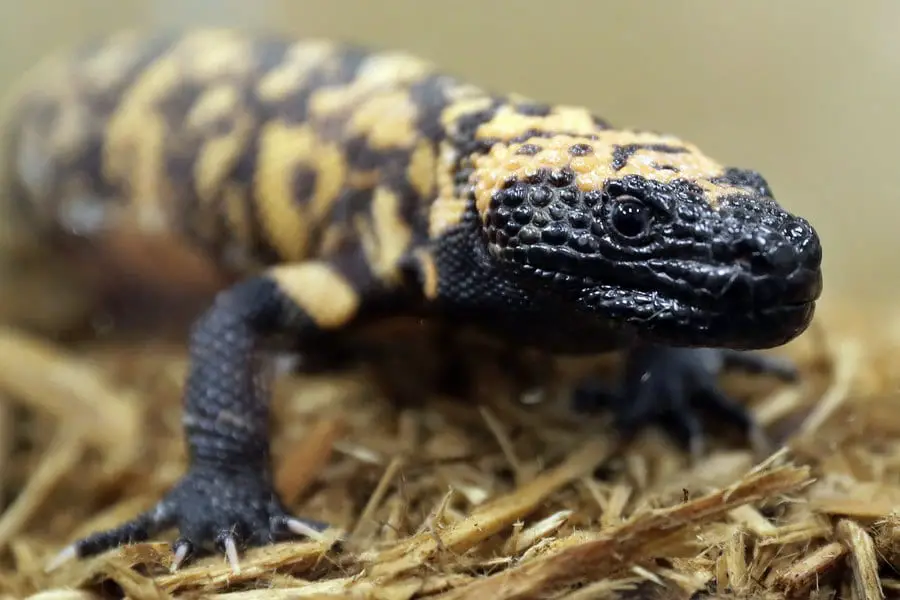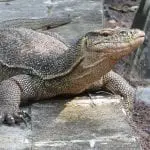Scientific Facts
| Common Name: | Gila Monster |
| Scientific Name: | Heloderma suspectum |
| Captive Life Span: | More than 20 years |
| Size: | 20 inches (50 centimeters) 4 lbs (1.8 kilograms) |
| Habitat: | Underground burrows located in rocky foothills |
| Country of Origin: | Sonoran, Mojave and Chihuahuan deserts in the Southwestern United States and Northwestern Mexico |
Physical Description
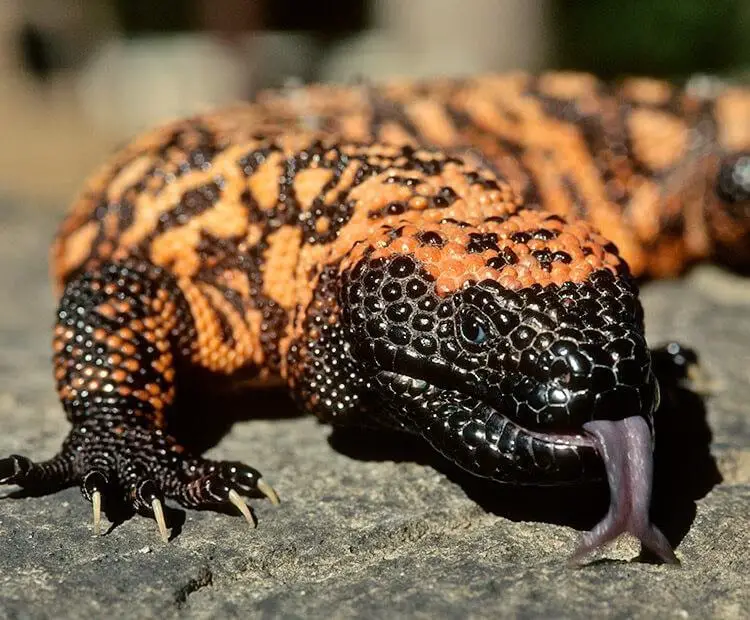
The Gila Monster is part of the only two venomous lizards living in the world. The other one is the equally famous Mexican beaded lizard with the scientific name of Heloderma horidum. The Gilas are big, sturdy bodies, and their tails are fat and short. Their maximum length is 56 centimeters. Their scales can be a mix of yellow, pink with the black combination.
Their chins and necks are color black, just like their legs and feet. Their ears are narrow while their limbs are sturdy; they have heavy claws that can grow very long.
Evolution
They belong to the Helodermatidae family, and these are compost of venomous lizards. While their animal order is Squamata, that is the category of modern scaled reptiles. Fossil evidence that has been unearthed shows that modern species of the Squamata evolved in the mid-Jurassic period, and most of them look like the snakes and geckos that we have in the present times.
The Cryptolacerta that has been discovered in Germany is known to be the oldest ancestor of the Gila Monsters. This discovery has given us the idea that the ancestors of the Gila Monsters belong in the Eocene epoch, and this is estimated to be 45 million years ago.
Looking at the adaptations and the behavior of both modern snakes and venomous lizards, it can be presumed that both of them may have come from a single venomous ancestor. The Gila Monster and the Mexican beaded Lizard underwent a lot of adaptations to ensure their survival in their desert environment.
Their body parts have been designed to survive extreme conditions in scrublands and deserts such as their scaly skin and its color and their grooved teeth. Evidence shows that the oldest and the closest species related to the modern Gila Monster is the Heloderma Texana that is believed to have lived in the Miocene era.
Gila Monster Adaptations
- Their skin color serves as camouflage, and this protects them from future predators.
- They can be seen swinging their tails from one side to another in order for them to balance their movement as they climb trees or even walking on the branches.
- They can easily dig up burrows using their sturdy claws.
- In order for them to survive several months with no access to food and water, especially while in brumation, they use up the fat stored in their tails.
- They can track out the scent of their prey as they flick out their forked tongues; this is because they have an excellent sense of smell and taste.
Eating Habits
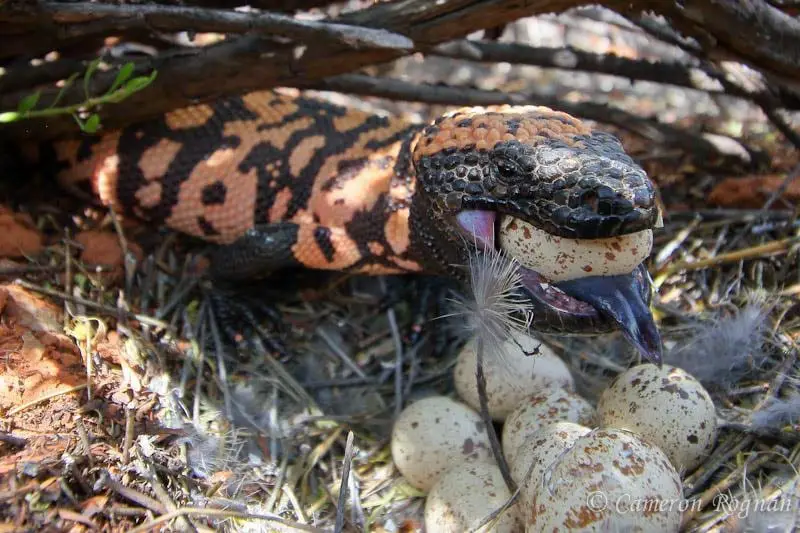
The Gila Monster feeds on a lot of food items while in the wild, they can eat small mammals like mice squirrel and even young rabbits. They can be seen feeding on birds, lizards, snakes, turtles, tortoises, and they are normally out hunting for eggs. In just one sitting, they will gladly consume a large amount of food. The young ones can consume up to 50% of their body weight in just a single feeding while its 35% for the adults.
This feeding method has been proven to be beneficial, especially for animals living in the wild, since the availability of food may be difficult. It has been found out that the Gila Monster will rarely use its venom to kill their prey; this indicates that their venom is primarily used as a self-defense feature.
They will use their tongue in detecting their prey, and they pair this with an excellent sense of smell. They don’t chew their food. What they do is to swallow it whole, but for the eggs, they break them open first.
Having a bigger body build means that they are capable of storing more energy compared to the small lizard species. They can store fat on their tails and in their bodies. They will don’t need to search for food all the time since they have a low metabolic rate paired with their capacity to consume large portions of food in one feeding and being able to store fat.
They will often stay underground completely hidden in the wild, and it also been found out that Gilas can have all the calories they need for the whole year by just eating 3-4 large meals.
Gila Monster Venom
Although human fatalities due to a Gila Monster’s venom is not typical, this doesn’t mean that their venom should not be taken seriously. In the wild, they can be seen literally using their teeth to instill the venom. Their venom will also come from modified salivary glands located in their lower jaws. The venom will be delivered into the victim via chewing.
If you ever find yourself stuck in a very rare situation of being bitten by a Gila Monster. Keep in mind that you should never pull the Gila from the ground; this will only result in more damage, including a possible rupture on your skin.
Their bite can become very persistent, and it may seem that the only way to stop them from biting further is to drown them in water. As you free yourself from a Gila Monster’s bite, you should seek medical treatment as soon as possible. Time is essential as you need to counter the possible effects of the venom quickly.
Sleeping Habits
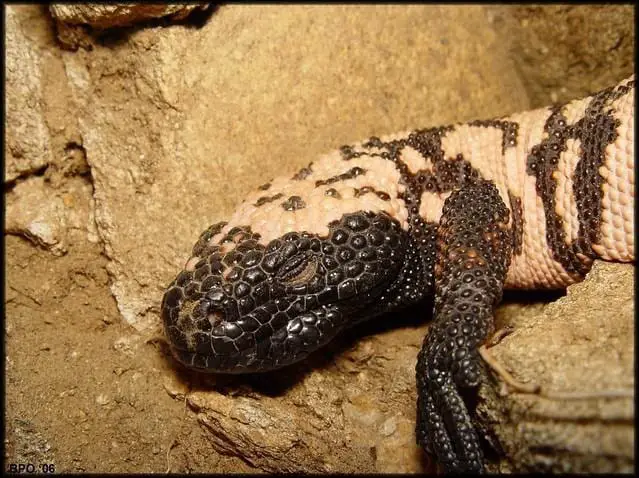
Although they spend most of their time completely hidden, the Gila Monsters are diurnal, and they are active mostly in the morning. Their above-ground activities will occur in spring.
Surviving Dry Months
They are known to live in deserts where water sources can be inadequate for several months. Scientists believe that the only way for a Gila Monster to sustain its water balance internally is by gaining water through the food it has eaten mainly on nestlings and eggs. Their prey is mostly 70% water, so it’s a decent source of water during the dry season.
Development and Reproduction
They will usually begin mating in May. This process initiates with the male flicking its tongue to locate a female’s scent; he will also rub his cloaca on the ground. If the male finds a female, he will then lie beside her while rubbing his chin on the female’s back and neck. He will also hold the female with the back of her legs.
A sign of rejection is that the female will bite the male and will crawl away from him. However, if she favors the male, she can be seen raising her tail. The male will then position his tail under the female’s tail, and this brings their genitals in contact. Their copulation is quite long compared to animals, this normally lasts for 30 minutes, but it can even take up to an hour. Egg-laying will usually happen in July or August, and the female will lay her eggs in a cavity located underground.
Offspring
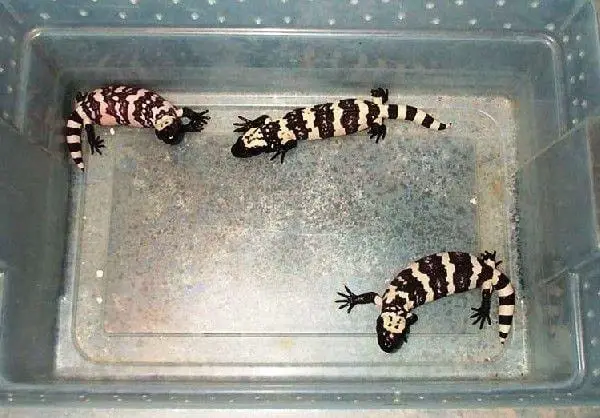
The Gila Monsters lay eggs just like any other lizard species. The number of eggs laid varies, but normally, it can range from 3-13. An incubation period that will last for 4 months should be given to the eggs. The usual size of their eggs is about 2.5 inches (6.3cm) long, and they are about 1.4 ounces (40grams). A baby Gila Monster can be about 6.3 inches (16cm) long at birth.
How to Breed
Captive breeding can be difficult for owners since the female Gila Monster can be very picky when it comes to sex. You may start breeding by properly determining the sex of the Gila Monsters; that’s why it’s advised to let them undergo an ultrasound. This is completely safe and relatively accurate. In the wild with no technology involves, their natural mating begins by the male trying to attract the female to start the copulation process.
Common Health Problems
Obesity is probably the biggest health issue among the Gila Monsters. They are usually at risk of being obese since they have a very low metabolism rate, and they will eat as much food as they can in just one feeding. The growth rate can be very fast, but this will slow down as they reach maturity, and this is the age where they become obese. If you have a captive Gila Monster, you can avoid this feeding them with only the amount necessary.
Behavior
1) Behavior during Warm Weather
They can be seen feeding on small mammals, eggs, and birds. During the warm weather, they will store fat in their tails and stomach to ensure that there is enough fat that can be used during the winter months.
2) Climbing Trees
They can be good climbers, and they are often seen climbing one in the wild. Their long claws are put to good use when they have to climb trees as necessary. These claws are also used for digging food like buried eggs and for modifying burrows.
Gila Monsters are seen climbing trees since this is their way of escaping potential predators. Also, they are trying to cool off a bit when the ground gets too warm for their skin.
3) Slow Pace
They are slow-moving yet very aggressive in nature, and this is primarily the reason why they prefer to live isolated from other creatures. They don’t have good eyesight compared to other lizards who have clear eyesight. Researchers think that because they have poor eyesight, they can become very aggressive to anything that comes close to it. They will not be seen risking themselves in a place they know that is not safe.
4) Biting Humans
There have been reported cases that a Gila Monster has bitten humans, but there is no concrete evidence that can lead to saying that a Gila Monster will go intentionally hunting for them or they like taking small children as their dinner. These stories are often associated with the myths that have been circulating in different cultures for quite a long time.
Their bite can make humans very sickly because of the bacteria that is found on their mouth. The effects of the venom can be very ill, so it’s highly recommended that a person who has been bitten by a Gila Monster should seek immediate medical attention.
5) Ability to Memorize
Gila Monsters have been observed to follow small mammals to their burrows. They will check if the small mammal is feeding their young ones. However, if they notice that the burrow doesn’t contain any newborns, they will not give up just yet; instead, they will go to that burrow again and again until he sees that there are young ones that will serve as his dinner.
It’s has been found out that their memory can contain data that up to 20 years, and this shows that they can be a mastermind of its own.
6) Likes to be Alone
They can be really solitary and shy; that’s why they are often seen spending their time in rocky shelters or burrows.
7) Doesn’t share shelters
They have a very loose social structure, and they are seen rarely sharing their shelters.
Brumation Cycle
Post breeding may let your Gila Monster experience refractoriness to light and temperature stimulation. This only means that light and temperature conditions that should stimulate the reproductive system there will be no stimulation to occur. This is very common to reptiles.
In order to break this refractoriness and bring back their sensitivity to light and temperature conditions, they should be given a period of short days or exposure to cold temperature. These conditions will stimulate the reproductive system once again. This can be easily done if they are placed in a cold environment.
Placing them in environments with a temperature of 13-14 degrees Celsius or 55-57 degrees Fahrenheit is recommended for optimum wellness for your pet Gila Monster. This can take place anytime in December until the first weeks of March.
It’s also advised that they should not be given food at least two weeks before this cooling period to ensure that they have fully digested their last meal. Their brumation season will start when there is a decrease in temperature until they have reached the final cooling temperature is achieved. In spring, you can gradually start to increase the temperature.
You have a lot of choices that can help you in cooling their tanks. You can have the temperatures lowered automatically as this mimic the kind of temperature they experience in the wild. You can also use computer-controlled devices so you can manage temperature levels effectively.
Always have easy water access for your Gila Monster even though they are in brumation. They will use this for drinking, and it helps in increasing the humidity of their environment. You can place it in a container that can’t be easily knocked over by the Gila Monster. Adequate humidity should be given as this prevents dehydration. Dehydration poses a serious risk to younger and smaller Gila Monsters.
Gila Monster Predators
The Gila Monsters belong to the small percentage of animals that are lucky enough to have a fewer number of predators. Their known predators are still humans. A lot of people will go intentionally hunting and seizing Gila Monsters, and they treat them like trophies that can be displayed. Some people will also believe that the Gila Monster can be something of value.
They are at bigger risk once the predator approaches them since they have poor eyesight. Birds, coyotes, foxes, and mountain lions are just some of their known predators.
Habitat
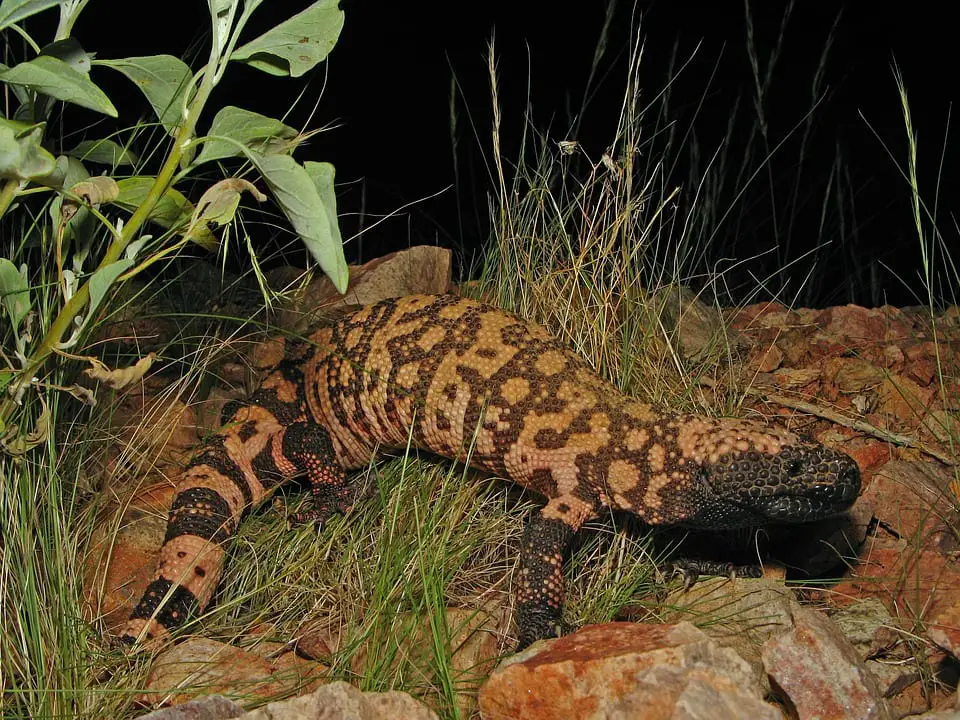
They are seen living in burrows and in rocky crevasses in the wild. If you are considering getting a Gila Monster as a pet, you should do your best to mimic their natural environment to ensure their chances of survival. Their tanks should also have a lot of space for the Gila to move around.
Tank and Substrates
Gila Monsters can become very large animals, and it’s necessary for them to have large enclosures. The minimum size requirement for a Gila Monster enclosure should be at least 4x2x2 ft (1.3x.66x.66m), but you can always go for a bigger one. If you plan to house multiple Gila Monsters in one enclosure, you can use large cattle stock tanks, Large tanks with adequate heat and hiding spots are always recommended.
You need to ensure that their enclosure comes with a cover as this provides safety not only for the Gilas but also for humans living in your house. They are considered wild, venomous, dangerous, and they will not like it if they are constantly being poked or provoked by others. Spot-cleaning their tanks daily is recommended, while weekly disinfecting the cage would ensure the health of your Gila Monster.
The items or accessories placed inside the tanks should be disinfected as well. Having the appropriate cleaning materials will become very handy. Chlorine or alcohol-based cleaners are always a good choice and stir away from using phenol-based cleaners.
You can use playground sand, bark chips, peat moss, newspaper, and natural substrates as flooring in their enclosures. This can be easily purchased from retailers online and retail stores. They should be deep enough to successfully absorb moisture yet not too deep that it might hide feces or uneaten food that may cause health issues in your Gila Monster.
Replacing soiled or dirty substrates immediately should be done so that it will not accumulate bacteria. Keeping them as dry as possible is also a good idea.
Habitat Accessories
1) Water
They love soaking in the water, so placing a good type of water dish is a good way for them to encourage doing so. Replace their water daily or once you that it’s dirty. Make sure that the water dish is sturdy.
2) Den
Since they spend most of their time inside their dens or in their burrows, they will require a den that has a similar space like that in the wild. Ensure that their dens have a large space so they will be given a chance to move and explore their tanks.
3) Humid Site
They also love high humidity levels despite living in deserts naturally. You can mimic this in their enclosure if you build a simple humid site. You should use a plastic container that is big and comfortable enough for the Gila Monster. Cut a hole on one end and put moist peat or sphagnum. Let your Gila Monster enjoy your DIY humid site.
Lighting and Temperature
1) Temperature Requirements
They are cold-blooded, and they are known to make use of external sources so they can regulate their body temperatures. They expose themselves to sun and shade in the wild. You can place heated and cool areas in their enclosures.
The optimum temperature should range from 85-90 degrees Fahrenheit or 29-32 degrees Celsius under a light that can be used for basking. An elevated rock that is placed under a basking light can be their simple basking area. If you live in an area that frequently experiences power outages, you need to have a backup plan since having optimum temperature is very critical for the development of Gila Monster.
2) Lighting
In the wild, they are used to having a scheduled period of darkness and light. Being diurnal species, they should be given a naturalistic photoperiod. After their brumation period, they should be given 8 hours of light and 16 hours of darkness. You should increase this in the summer, and the maximum duration of light can be 14 hours, while it can be 10 hours of darkness.
Availability – Where to Get One
You need to follow local, state, and even federal laws if you have plans of getting a Gila monster as a pet. You need to look for a reputable Gila breeder to learns the specifics of having one as a pet.
How to Care for a Gila Monster
Legally purchasing captive-born offspring of a Gila monster might be the only way to have it as a pet. Although they can be interesting captives, they can be very difficult to take care of also. If you plan on having multiple numbers of Gilas, you should be able to house them individually to feed them easier.
A lot of breeders became successful in breeding whenever they use a colony approach in which Gila Monsters are separated during their feeding period. They should be monitored closely, especially during the breeding season; this is to ensure that the male Gila Monsters will never hurt each other.
Climate Change and its Effects on the Gila Monster
Gila Monster’s name came from the Arizona Gila River Basin, the place where they have been first discovered. New researches mention that the Gila Monsters are now being exposed to new threats when it comes to structural developments from humans and the changing climate in their natural environment.
They are classified as near threatened, but this status might change for the worse soon. This is the proposition of some scientists. People have tried counting the estimated number of Gila Monsters there is, but no one knows their exact number. This is because of their natural behavior wherein they spend most of their days hidden underground, and it’s difficult to actually count them at night. It’s suggested that it might take years to get their exact numbers in a given location.
Climate models suggest that the Southwest area might get a higher temperature level of about 3-5 in an 80-year period. However, this temperature increase will not have a direct effect on the Gila Monster as they are mostly living underground and is active at night. The main impact will be on how they are able to keep enough water in their tissues.
This might be the reason why currently, they have been located in the Sonoran Desert as this has a summer monsoon season that will either begin in July or in the early weeks of August. Scientists have always believed that a Gila Monster will never be able to survive in the Sonoran Desert, but this discovery has proven them wrong. The Gilas have lived in this desert for quite a long time.
Laboratory finding has reported that the Gila Monster can thrive for 81 days with a full bladder, and after this period, it will start feeling lethargic. Once their bladders have been emptied, it will only take them 32 days. This is in between the time that the spring rains and summer monsoons are present in the Sonoran Desert.
Biting Facts about the Gila Monster
Gila Monster is actually more common than what we might have believed
The venomous lizards, just like the Gila Monster, is actually more common that what we might have believed. The world houses up to more than 4600 lizard species, and we have always believed that only the Gila Monster and the Mexican beaded lizard produces venom. Reports have mentioned that this venom feature may be widespread.
Bryan Fry, a biochemist, identified venom-secreting glands within the mouth of monitor lizards, iguanas, and alligator lizards. He discovered this in his study conducted in the mid-2000s. A terrifying fact that is a result of his study is that even Komodo dragons are very venomous as well.
Getting bitten is one experience that you might never forget
If you happen to see a Gila monster in the wild, this may be very rare; you can give it all the admiration you like but give them a large space to still move around. A scared Gila Monster might open its purple-gummed mouth and hiss in a theatrical display. This is already a good sign that you need to leave it alone, but for some people, they will not just get the message an insists on keeping close.
If the person fails to move away, it’s just natural for the Gila Monster to release their aggressive state and will bite. The way they deliver the venom can be as painful as the venom itself. We might get the idea from their co-reptile species, which is the snake, that bites its victim by using their hollow fangs that looks and acts like syringes and will pump up the venom into the victim’s bloodstream.
A Gila Monster’s bite can feel like torture for the victim
Their powerful jaws will hang on to the victim, and they can stay still for about 15 minutes. It will withdraw its venom from its storage glands that are found in their lower jaws. The venom will then move along the tooth and will then enter the wound.
If you have been bitten, you can try dunking the head of the Gila Monster underwater. You may experience having a fever, nausea, high blood pressure, vomiting, fainting, perspiring excessively, and swelling.
You will not find any other native lizard that is bigger than a Gila Monster in the United States
The adult Gila Monsters can grow up to 2 feet, and they can become very heavy. With these body measurements, it has been proven that they are the largest lizard that can be found in the United States. However, if they are placed beside invasive Green iguanas and Nile Monitors, they can look very small. Nowadays, both of these animals live in Florida, and they can reach up to 5 feet long,
If your planning on visiting or observing them while on their natural habitat in the US, you need to go west. If you are on the Mexican border, the Gila Monsters sightings are frequent in Southern, Central, and Western Arizona. California, Nevada, Utah, and New Mexico are also good places to spot them.
They love eggs
They always have a good preference for eggs, and raw eggs are a good option for their menu. Smaller eggs are typically swallowed whole by the Gila monster, while the large ones can be a bit challenging to devour. The Gilas will crack these open first and then devour the contents using their forked tongues.
Their love for eggs has made them hunt for it via climbing trees that can be as high as 8 feet from the ground. From this viewpoint, they can easily spot vulnerable nests.
They have mastered storing fats in their tails
Unlike the other lizard species, a Gila monster can’t lose and regrow its tail. Well-fed Gila Monsters will store and reserve fats in their tails, and this has helped them in surviving with only 3-4 large meals in a year.
There might be two different subspecies
Gila monsters will often look alike. The newborns are known to have a bright color scheme, and they have alternating bands. The other half of the band can be black, while the other colors can range from orange to yellow to pink. As they grow older, there’s a higher chance that they will still have the same markings.
As the days progress, some species begin to develop a more marbled appearance that has blotches of black that are scattered across a bright orange background. These differences may be more than just their skin, and some herpetologists believe that there are two wide varieties that might be from two separate subspecies.
Male Gila Monsters know how to wrestle
Their mating season will not only display their mating scenes, but it’s also a time to display the male’s strength via a wrestling match. These are considered an intense affair. This will happen when two adult males’ cross paths in late spring or early summer, once they bump into each other, they will try to pin each other in the ground.
This wrestling match can go for countless rounds and may take several hours. This match will go on and on until one of them finally retreats. The rewards will normally include getting to mate with a certain female and being able to choose their own breeding site.
Some of the breeding sites already have a female housed in them, but this is not an assurance that the female wants to mate with the male. The breeding ritual will begin with the male lying down with the female.
They don’t go out that much
Researches have suggested that a Gila Monster will stay hidden underground in about 95% of their lives. Ideally, their home will be abandoned mammal burrows, packrat nests, and crevices found in large rocks.
They will spend a total of 3-4 weeks equivalent every year above ground. Their excursions will usually happen at night and mostly during the months of April and May.
Their venom has inspired a Diabetes-fighting drug
A research done by John Eng, an endocrinologist, has done research in 1992, and he made a discovery that the Gila Monster’s venom has a peptide that he later called exendin-4. When exendin-4 is introduced to our bloodstream, the compound will then increase the production of insulin.
Human bodies are capable of releasing a similar hormone, but the production is not stable and lessens in less than 2 minutes. Eng’s discovered compound is found to be functional for several hours.
He also initiated efforts to have exendin-4 synthesized, and this has become the main ingredient of the medication called Byetta. This has been largely used by people suffering from Type 2 diabetes.
An Iconic Gila Monster movie didn’t use a real one
If you are familiar with the 1959 movie The Giant Gila Monster, this has starred a 70-foot Gila Monster that can be seen roaming in the countryside gobbling up hitchhikers, truck driver, and teenagers.
The movie will show a lizard that is plodding through miniature houses and streets, and the effects team made use of a Mexican beaded lizard and not an actual Gila Monster. In the movie production’s defense, both of the lizard species are very close when it comes to physical appearance, and they belong to the same lizard family.
FAQ Section
Why do you need to study Gila Monsters?
Even though the Gila Monster is quite common in the Sonoran Desert, they are rarely encountered. The reason for this is that they spend up to 98% of their lives underground, and they will only go to the surface at certain times of the year. Having an elusive nature has been made it difficult to determine their exact population, morphology differences, movement, and behavior.
Are Gila Monsters venomous?
The answer to this has always been yes. However, a Gila Monster will never bite unless harassed or handled. If, however, they do bite, they will not let go of the victim and will begin chewing to release the venom into the wound. The venom will then be released from their glands in the lower jaw. Although this venom is extremely painful, they are also rarely fatal.
Are Gila Monsters slow-moving?
Their pace is dependent if they feel threatened or not. They have the tendency to move extremely fast when they are provoked, and they will swing their entire body around to initiate a strike and will definitely attack a potential predator. While a Gila Monster who doesn’t feel threatened will have, slow pace that is usually steady.
What is the best time to look for Gila Monsters in the Wild?
They are dormant during the winter and will emerge in March from their hidden burrows. They are active during the day from April to May, and in the summer monsoons, they can be seen along the roads in the middle of the night. While in July and August, they will lay their eggs in a burrow, and the young ones are expected to emerge in spring.
Why are Gila Monsters so bright?
The primary reason for this is to warn other animals that they are venomous creatures. While the second one is that their color serves as a camouflage so that they can stay hidden when they are outside.
Are Gila Monsters endangered?
No, but they are protected, and this means that they cannot be killed, bought, or sold in some states in Arizona.
Can Gila Monsters get water through their food?
They seem to get well-hydrated in their food. They will also only eat the contents of nests from other reptiles like birds and small mammals.
Do Gila Monsters lose water through their skin?
All reptile species will lose water through their skin, and it has been found out that Gila monsters have a skin that leaks more water than most desert reptiles. One disadvantage of having water stored in their bladders is that it can slow down the Gila monster, and it will feel like they are carrying a big water tank.

